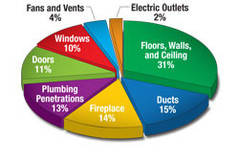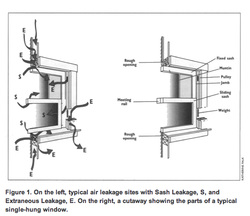Home Energy Losses
|
Depending on the climate where you live, your home's age and condition, sources for energy losses vary. A sample pie chart can be found to the right.
From this chart you can see that there are several other sources of air leaks that, if addressed, would have a greater effect on your home heating bill than replacing the windows. However, no issue can be that simple, right? Right. For a very interesting article that goes into much more detail about the different types of air leaks around windows, and comparison between different age and types of windows, see this online article in the September/October 1997 issue in Home Energy. In a nutshell:
Depending on the answers to the above questions, replacing the window may or may not address the issue. And all these issues can be targeted specifically without the need for replacement. Here's a "for instance:" One of your windows is no longer functional (painted shut & broken sash cords) and it is very drafty (despite being painted shut). Most window companies suggest ripping out the original window and installing a nice-looking (= expensive) new window as the only remedy. I (and other reputable window companies) would suggest looking at the reason why the window is drafty. Very often when I visit homes with all painted shut windows I will find one or two that display the "Seattle Painters' Special." That's what I have dubbed the situation where a painter has painted over the seam between sash and frame, making the window inoperable (it only takes a bead of paint a few inches long to make the window feel like it NEVER opened). This is preferably done with the upper sash slightly too low (see images on the right), so that the lock doesn't meet properly and there actually is a gap between the horizontal meeting rails. It's called an open window. Because the faces between the two rails are angled, as soon as the upper sash is too low, you have a gap and even though the sashes have been painted shut around their exterior perimeters, the air rushes in (and out) between the two rails. My suggestion: let's close the window (by freeing up the sashes and moving the upper sash into the fully closed position) and see how much we reduce the draft. |
|




